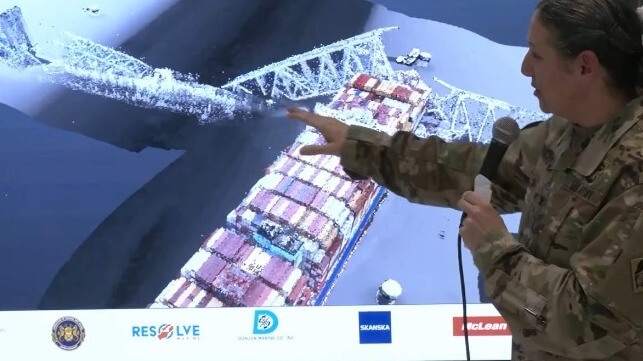Wrecked Bridge Section is Buried in Mud in Baltimore Shipping Channel
Army Corps says it may have to be removed another way, without cutting

The unified command for the response to the Francis Scott Key Bridge disaster has warned that clearing Baltimore's main ship channel will be difficult, and on Tuesday, they laid out the details of the daunting challenge ahead. The bridge's massive center span has collapsed in the channel, and the portion resting on the bottom is a tangled mess of steel I-beams. Worse, it's buried in the soft mud of the bottom.
Based on surveys, the wreckage on the bottom of the deep-draft channel is "far more extensive than we could have imagined," according to Colonel Estee S. Pinchasin, commander of the U.S. Army Corps of Engineers' Baltimore district.
"It's not just sitting on the seabed, it's actually below the mud line," said Pinchasin in a press conference Tuesday. "The state of that wreckage makes it very difficult to figure out where to cut, how to cut, in order to put it into bite sized pieces [for hoisting]."
 Sonar imaging of the central span shows tangled girders intermingled with mud (U.S. Navy Supervisor of Diving and Salvage)
Sonar imaging of the central span shows tangled girders intermingled with mud (U.S. Navy Supervisor of Diving and Salvage)
The span segments above the water will be difficult to evaluate, cut and lift, but the section at the very bottom of the channel - the most important area to clear for the functioning of the seaport - will be exceptionally hard to process in the same way, she said.
The removal plan for this wreckage may not involve cutting, because of the hazard to personnel from unstable wreckage. Instead, Pinchasin said that the unified command is mobilizing equipment that can do an "additional type of lift."
"This is something that the salvage community knows how to do," she said.
To help plan the operation, more dive surveys with sonar equipment are under way. All survey data from all government and industry partners in the unified command is being compiled in one database to build the most accurate possible picture of the wreckage. "With each layer, we're getting a much better picture of what it's going to take to lift that up," she said. "We are now developing our plan for that [sunken section]."
The team is moving with safety in mind first. The tangled wreckage in the center of the channel is "extremely unforgiving" and dangerous for dive teams to work near, Pinchasin said. Salvage divers are working in near-darkness and zero visibility, relying on verbal navigation cues from sonar-equipped boat teams on the surface.
"It's very methodical and we have to do it very carefully," she said.
